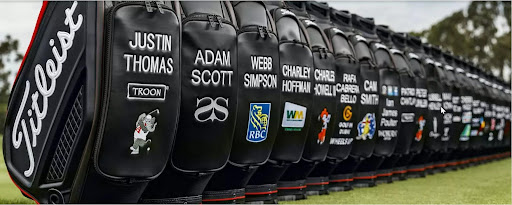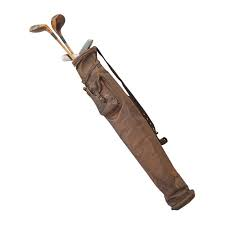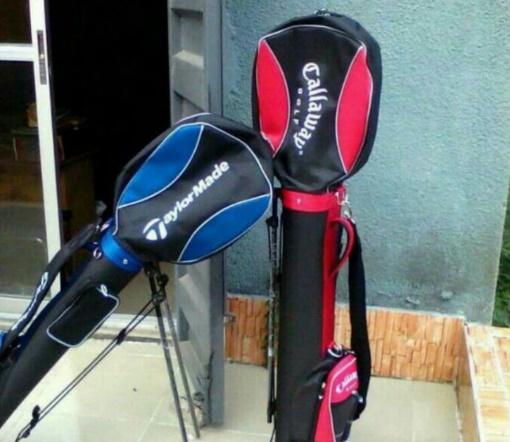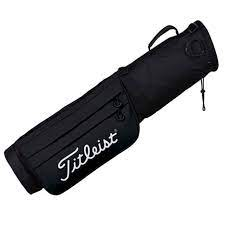The History


Before golf bags came around, the golf clubs tied together by a chord and carried around by the players. As the 20th century rolled around people wanted to play golf for longer than 9 holes. This led to the development of the first golf bag which was made of canvas and leather. It was just under 90 cm in height and had an opening for the clubs of 11.5cm. The bag was reinforced with metal at the bottom end of the bag for protection and stability. This design lasted from the late 19th century all the way until before World War Two.
After World War Two people wanted to play golf for longer of periods of time so they could fit 18 holes of golf in. This led to the need for lighter and more comfortable bags that were big enough to fit all the clubs, balls and course books they needed. As result leather and canvas were replaced by lighter materials. These lighter materials became vinyl and cotton up until the mid-1980s where they were replaced by nylon, plastic, and other compounds.
However, due to the invention of the golf buggy and pull cart/trolley bags became heavier and bigger as they were no longer needed to be carried. Consequently, the bags began to be made out of vinyl and cotton in the 1970s. Towards the end of the 1970s and the begins of the 1980s the golf bag began to develop into having two legs (kickstands) to supports its weight. It also began to feature two straps to carry the bag to spread the weight onto both shoulders.


In the 1970s there was a change in bag design back to a carry bag when Rick Reimers took ideas from backpack companies – such as materials and design – to help make a new golf bag. This new golf bag was made out of nylon and was more durable and half the weight of other bags of the time. Later on, with his development of golf bags in 2004 came the invention of a Roller Top Handle. This handle allowed the bag to be mounted and dismounted from the shoulders much easier. As a result, this design would be copied by many other manufacturers and is still in use today. Rick Reimers went even further with his golf bags in 2007 when he released the first ever waterproof golf bag.
Nowadays golf bags are extremely light at around 2KG and have loads of added features, such as: lots of spaces for balls and other accessories, comfortable straps that distribute the weight evenly across your shoulders, a rain hood that stops your clubs from getting wet in the rain and much more.
Different Types of Golf Bags
| Type of Bag | Advantages | Disadvantages |
|---|---|---|
Stand BagsThese bags are very light weight and come with two legs that can make the bag stand up as well as two straps to help carry the bag on your shoulders. |
|
|
Cart BagsThese bags have a flat bottom to them and are designed to be put on a golf trolley and not carried. This means that the pocket layout is different and there are no legs or straps to carry your bag. |
|
|
Pencil BagThese bags are extremely small and light weight, designed to hold not much more than a set of clubs |
|
|
Tour BagThese are the bags you see with the professionals. they have loads of space but are very heavy |
|
|
Most Popular Golf Bags
TITLEIST PLAYERS 4PLUS STADRY STAND BAG
Pockets: 8
Waterproof: Yes
Colours: 9
+Numerous pockets provide lots of storage
-Legs don't fully retract when being carried
Pockets: 11
Waterproof: Not fully
Colours: 3
+Extra, tailored rangefinder pocket
-Less robust
-One of the heavier bags on the market
SUN MOUNTAIN H2NO LITE SPEED STAND BAG
Pockets: 6
Waterproof: Yes
Colours: 6
+Beverage pouch included
-4-way top might not be enough separation for some
DATREK 2022 CARRY LITE STAND BAG
Pockets: 5
Waterproof: No
Colours: 6
+Lightweight
+Comfortable staps and added hip padding
-Not waterproof
Pockets: 8
Waterproof: Not fully
Colours: 3
+Easy to organise your gear
-Not fully waterproof
BIG MAX DRI LITE FEATHER STAND BAG
Pockets: 6
Waterproof: Water-repellent
Colours: 5
+Loads of storage space
+Sturdy despite the low weight
-Straps are difficult to adjust – uncomfortable
CALLAWAY FAIRWAY C HYPER DRY DOUBLE STRAP STAND BAG
Pockets: 4
Waterproof: Yes
Colours: 3
+Sleek, lightweight and stylish
+Comfortable
-Not enough pockets
Pockets: 7
Waterproof: Not fully
Colours: 7
+Durable but stylish
-Not fully waterproof
Pockets: 5
Waterproof: Yes
Colours: 3
+Spacious and accessible pockets
-Bigger than and heavier than other bags
BIG MAX DRI-LITE HYBRID TOUR STAND BAG
Pockets: 5
Waterproof: Yes
Colours: 7
+Fits very well on a golf trolley/cart
-Not very stable
-Zips are tricky to handle
Weight: 5.1 pounds / 2.3Kg
Colours: 5
Dividers: 14
Waterproof: Yes
+Extremely lightweight
+Very functional
-Boring design
BIG MAX DRI LITE TOUR CART BAG
Weight: 5 pounds / 2.26Kg
Colours: 6
Dividers: 14
Waterproof: Yes
+Light but with lots of storage room
+Highly functional design
-Bulky, takes up a lot of space
Weight: 7 pounds / 3.2Kg
Colours: 11
Dividers: 14
Waterproof: No
+Loads of pockets provide plenty of space
-Not waterproof
MOTOCADDY 2022 DRY SERIES CART BAG
Weight: 6 pounds / 2.7Kg
Colours: 4
Dividers: 14
Waterproof: Yes
+Insulated food/ beverage pocket
+Excels in wet conditions
-Dull colours and designs
Weight: 5.5 pounds / 2.5Kg
Colours: 6
Dividers: 14
Waterproof: No
+Outstanding storage space due to the 13 pockets
+Lots of accessories
Not waterproof
Weight: 5.4 pounds / 2.45Kg
Colours: 9
Dividers: 14
Waterproof: No
+Large, removable cooler bag for drinks
-No front handle – hard to manoeuvre.
Weight: 5.3 pounds / 2.4Kg
Colours: 2
Dividers: 14
Waterproof: Yes
+Extra-large cooler pocket
-Quite big and chunky so takes up a lot of space
Weight: 10 pounds / 4.5Kg
Colours: 5
Dividers: 12
Waterproof: No
+Impressive storage capacity
-Not waterproof despite high price
Weight: 5.5 pounds / 2.5Kg
Colours: 5
Dividers: 14
Waterproof: Yes
+Trendy design
-More expensive than competitors
Weight: 4.2 pounds / 1.9Kg
Colours: 13
Dividers: 14
Waterproof: No
+Good value for money
-Not enough pockets
-Not waterproof
What Bags do they use on Tour?


The professional that we see on TV use a different bag to the rest of us. They use a much bigger bag, it has loads of space for added gear that they might need. This extra space comes at a cost as they weigh 4.5Kg or 10 pounds. However, the professional doesn’t need to worry about weight as they have a caddy to carry the bag for them.
The main differences between a tour bag and any other bag are that the diameter of the tour bag is much wider at 10 inches wide. Some more difference is, that the bag has a single strap to help the caddies carry the bag, they can stand up – much like a cart bag – and also have enough space on the bag for added sponsors like this ?

Over the years the general design and shape hasn’t changed much. With the main differences are the materials used and the size. As the bags have gone from heavy canvas to much lighter nylon and plastic. This has allowed the bags to become much bigger without gaining to much weight. Consequently, the Tour professionals have been able to carry round much more extra equipment to help them. These items include lots of food and drink, waterproofs (if they need them), plenty of golf balls, spare gloves and tees.
Pencil Bags


However, Pencil bags are the complete opposite to Tour Bags. They are extremely light at around 1.5 Kg in weight, and are 6 inches in diameter, substantially smaller than the 10-inch diameter of the Tour bag. This smaller size means that the bag is only really designed to carry a set of clubs and not much else. It does have space for added gear such as golf balls, tees and some bags have room for waterproofs. As a result of this design, pencil golf bags are meant to be carried round with comfort and ease due to them having two straps and being extremely light. The bag usually comes with two legs so it can stand but some pencil bags often don’t to save weight. These pencil bags, due to the design of being light are very small. They are the best option for if you have a small car, or a car with a small boot.

How pencil bags have changed over time, is mainly through the materials. These materials have changed from leather in the early designs, to canvas and cotton to save weight in the 1970s. This reduction in weight allowed for added featured such as legs to help the bag stand and extra pockets for other equipment. A further reduction in weight in the 2000s was caused by the production of bags made out of synthetic materials such as plastic and nylon. As a result, the bags could get a lot bigger without causing a change in weight. Consequently, the bags could have much bigger pockets and storage. Whilst they gain storage some brands often will not add legs to their bags, instead opting for extremely lightweight, and designed to be comfy and easy to carry.
